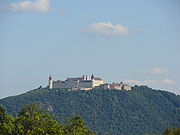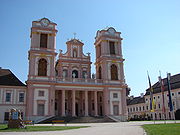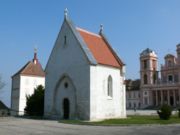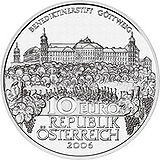
Göttweig Abbey
Encyclopedia




Lower Austria
Lower Austria is the northeasternmost state of the nine states in Austria. The capital of Lower Austria since 1986 is Sankt Pölten, the most recently designated capital town in Austria. The capital of Lower Austria had formerly been Vienna, even though Vienna is not officially part of Lower Austria...
.
History
Göttweig Abbey was founded as a monastery of canons regularCanons Regular
Canons Regular are members of certain bodies of Canons living in community under the Augustinian Rule , and sharing their property in common...
by Blessed Altmann
Altmann of Passau
Altmann of Passau , often called Saint or Blessed Altmann, was a founder of monasteries and Bishop of Passau. He is venerated as a saint, but not officially canonised....
, Bishop of Passau
Bishop of Passau
The Diocese of Passau is a diocese of the Latin Rite of the Roman Catholic church in Germany. It is a suffragan of the Archdiocese of München und Freising. The diocese covers an area of 5,442 km². The current bishop is Wilhelm Schraml.-History:...
. The high altar of the church was dedicated in 1072, but the monastery itself not until 1083: the foundation charter, dated 9 September 1083, is still preserved in the abbey archives.
By 1094 the discipline of the community had become so lax that Bishop Ulrich of Passau, with the permission of Pope Urban II
Pope Urban II
Pope Urban II , born Otho de Lagery , was Pope from 12 March 1088 until his death on July 29 1099...
, introduced the Rule of St. Benedict. Prior Hartmann of St. Blaise's Abbey in the Black Forest
St. Blaise's Abbey in the Black Forest
Sankt Blaise's Abbey in the Black Forest was a Benedictine monastery in the village of St. Blasien in the Black Forest in Baden-Württemberg, Germany.- 9th–12th centuries :The early history of the abbey is obscure...
was elected abbot. He brought with him from St. Blaise's a number of chosen monks, among whom were Blessed Wirnto and Blessed Berthold
Berthold of Garsten
Berthold of Garsten , also known as Blessed Berthold, is believed to be of the family of the Counts of Bogen and Vögte of Regensburg Cathedral. He was to begin with a Benedictine monk at St. Blaise's Abbey in the Black Forest and was then, in 1107, appointed prior at Göttweig Abbey...
, later abbots of Formbach and Garsten
Garsten Abbey
Garsten Abbey was a Benedictine monastery in Garsten near Steyr in Upper Austria. It is now a prison.-History:The abbey was founded in 1080-82 by Ottokar II of Styria as a community of secular canons and as a dynastic burial place for his family...
respectively. Under Hartmann (1094–1114) Göttweig became a famous seat of learning and strict monastic observance. He founded a monastic school, organized a library, and at the foot of the hill built a nunnery where it is believed that Ava
Ava (poet)
The poet Ava , also known as Frau Ava, Ava of Göttweig or Ava of Melk, was the first named female writer in any genre in the German language.-Life:...
, the earliest German language
German language
German is a West Germanic language, related to and classified alongside English and Dutch. With an estimated 90 – 98 million native speakers, German is one of the world's major languages and is the most widely-spoken first language in the European Union....
poetess known by name (d. 1127), lived as an anchorite
Anchorite
Anchorite denotes someone who, for religious reasons, withdraws from secular society so as to be able to lead an intensely prayer-oriented, ascetic, and—circumstances permitting—Eucharist-focused life...
. The nunnery, which was afterwards transferred to the top of the hill, continued to exist until 1557.
During the 15th and 16th centuries however the abbey declined so rapidly that between 1556 and 1564 it had no abbot at all, and in 1564 not a single monk was left here. At this crisis an imperial deputation arrived at Göttweig, and elected Michael Herrlich, a monk of Melk Abbey
Melk Abbey
Melk Abbey or Stift Melk is an Austrian Benedictine abbey, and one of the world's most famous monastic sites. It is located above the town of Melk on a rocky outcrop overlooking the river Danube in Lower Austria, adjoining the Wachau valley....
, as abbot. The new abbot, who held his office until 1604, restored the monastery spiritually and financially, and rebuilt it after it had been almost entirely destroyed by fire in 1580.
Abbots distinguished during the Reformation
Protestant Reformation
The Protestant Reformation was a 16th-century split within Western Christianity initiated by Martin Luther, John Calvin and other early Protestants. The efforts of the self-described "reformers", who objected to the doctrines, rituals and ecclesiastical structure of the Roman Catholic Church, led...
were George Falb (1612–1631) and David Corner (1631–1648), who successfully opposed the spread of Protestantism
Protestantism
Protestantism is one of the three major groupings within Christianity. It is a movement that began in Germany in the early 16th century as a reaction against medieval Roman Catholic doctrines and practices, especially in regards to salvation, justification, and ecclesiology.The doctrines of the...
in the district.
_-_imperial_stair_case_-_gttweig_abbey.jpg)
Baroque architecture
Baroque architecture is a term used to describe the building style of the Baroque era, begun in late sixteenth century Italy, that took the Roman vocabulary of Renaissance architecture and used it in a new rhetorical and theatrical fashion, often to express the triumph of the Catholic Church and...
in Austria
Austria
Austria , officially the Republic of Austria , is a landlocked country of roughly 8.4 million people in Central Europe. It is bordered by the Czech Republic and Germany to the north, Slovakia and Hungary to the east, Slovenia and Italy to the south, and Switzerland and Liechtenstein to the...
. Executed by Paul Troger
Paul Troger
Paul Troger was an Austrian painter, draughtsman and printmaker of the late Baroque period. Troger's illusionistic ceiling paintings in fresco are notable for their dramatic vitality of movement and their palette of light colors.Paul Troger’s style, particularly in his frescoes, dominated Austrian...
in 1739, it represents the Holy Roman Emperor Charles VI
Charles VI, Holy Roman Emperor
Charles VI was the penultimate Habsburg sovereign of the Habsburg Empire. He succeeded his elder brother, Joseph I, as Holy Roman Emperor, King of Bohemia , Hungary and Croatia , Archduke of Austria, etc., in 1711...
as Apollo
Apollo
Apollo is one of the most important and complex of the Olympian deities in Greek and Roman mythology...
.
The abbey has a library of 130,000 books and manuscripts, and a particularly important collection of religious engravings, besides valuable collections of coins, antiquities, musical manuscripts and natural history, all of which survived the dangers of World War II
World War II
World War II, or the Second World War , was a global conflict lasting from 1939 to 1945, involving most of the world's nations—including all of the great powers—eventually forming two opposing military alliances: the Allies and the Axis...
and its immediate aftermath almost without loss.
Since 1625 the abbey has been a member of the Austrian Congregation
Austrian Congregation
The Austrian Congregation is a congregation of Benedictine monasteries situated in Austria, within the Benedictine Confederation.-History:The Congregation was founded on 3 August 1625 by Pope Urban VIII, and consisted of eleven Benedictine monasteries in Austria:*Altenburg Abbey*Garsten...
, now within the Benedictine Confederation
Benedictine Confederation
The Benedictine Confederation of the Order of Saint Benedict is the international governing body of the Order of Saint Benedict.-Origin:...
.

